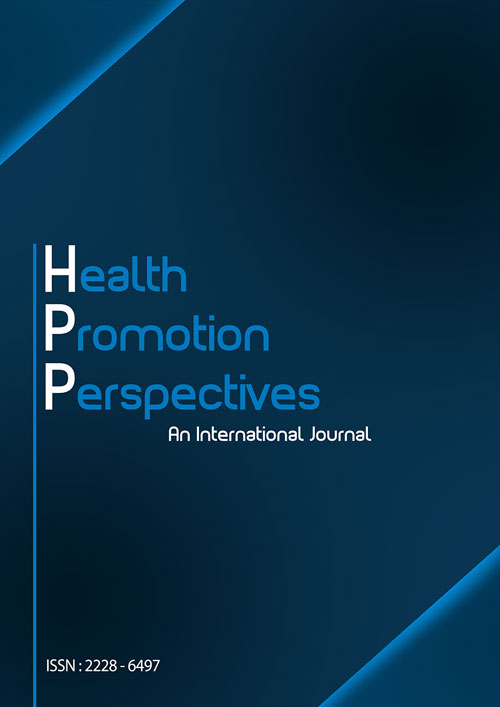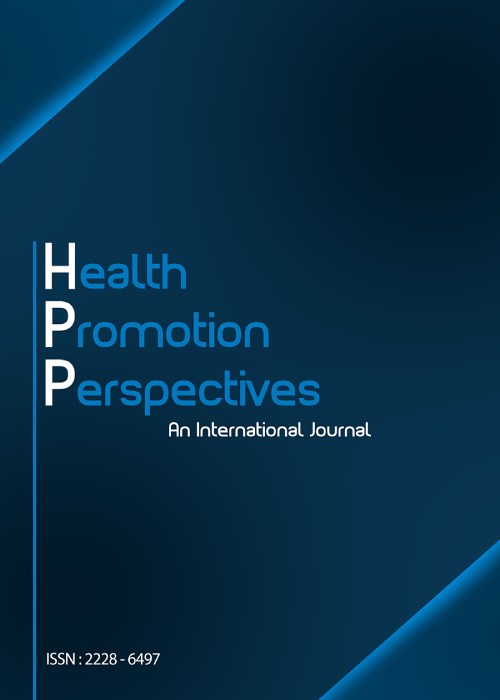فهرست مطالب

Health Promotion Perspectives
Volume:6 Issue: 4, Oct 2016
- تاریخ انتشار: 1395/08/03
- تعداد عناوین: 8
-
-
Pages 174-179BackgroundIn Peru, 11% of deaths are due to trauma. Iquitos is a large underserved Peruvian city isolated from central resources by its geography. Our objective was to implement a locally driven trauma registry to sustainably improve trauma healthcare in this region.MethodsAll trauma patients presenting to the main regional referral hospital were included in the trauma registry. A pilot study retrospectively analyzed data from the first two months after implementation.ResultsFrom March to April 2013, 572 trauma patients were entered into the database. Average age was 26.9 years. Ten percent of patients presented more than 24 hours after injury. Most common mechanisms of injury were falls (25.5%), motor vehicle collisions (23.3%), and blunt assault (10.5%). Interim analysis revealed that 99% of patients were entered into the database. However, documentation of vital signs was poor: 42% of patients had temperature, 26% had oxygen saturation documented. After reporting to registry staff, a significant increase in temperature (42 to 97%, PConclusionA trauma registry is possible to implement in a resource-poor setting. Future efforts will focus on analysis of data to enhance prevention and treatment of injuries in Iquitos.Keywords: Global health, Injury, Trauma Registry
-
Pages 180-184BackgroundNo study has evaluated the effects of executive function on follow-up sedentary behavior, which was this studys purpose.MethodsA longitudinal design was employed among 18 young adult college students (Mage = 23.7 years; 88.9% female). Accelerometer-determined sedentary behavior and physical activity, along with executive function, were assessed at baseline. Approximately 8 weeks later, re-assessment of accelerometer-determined sedentary behavior and physical activity occurred. Executive function was assessed using the Parametric Go/No-Go (PGNG) computer task. From this, 2 primary executive function outcome parameters were evaluated, including the Simple Rule and Repeating Rule.ResultsAfter adjusting for baseline sedentary behavior, age, gender, body mass index and baseline moderate-to-vigorous physical activity (MVPA), for every 25% increase in the number of correctly identified targets for the Repeating rule at the baseline assessment, participants engaged in 91.8 fewer minutes of sedentary behavior at the follow-up assessment (β = -91.8; 95% CI: -173.5, -10.0; P = 0.03). Results were unchanged when also adjusting for total baseline or follow-up physical activity.ConclusionGreater executive function is associated with less follow-up sedentary behavior.Keywords: Accelerometry, Cognition, Inhibition, Intention, Planning, Set, Shifting
-
Pages 185-189BackgroundThe purpose of this study was to investigate the relationship between physical inactivity (PIA) and health-related quality of life (HRQOL) in rural adults and examine the extent to which sex differences exist in this relationship.MethodsA total of 5617 adults 18 years of age and older who indicated residing in a rural county was included in this analysis. PIA status was assessed by questions regarding recreational physical activity during the previous month. Five HRQOL measures (physical health, mental health, inactivity health, general health, & unhealthy days) were used as primary outcome variables. PIA and HRQOL prevalence estimates were computed with 95% CIs. Multiple logistic regression was used to obtain odds ratios (ORs) and 95% CIs adjusted for age, ethnicity, and income.ResultsPhysically inactive rural adults were significantly more likely to report poor HRQOL in all overall crude models with ORs ranging from 1.59 to 2.16. Additionally, sex-by-PIA interactions were significant across all crude HRQOL models with ORs ranging from 2.27 to 3.08 and 1.56 to 2.42 for women and men, respectively. Sex differences were maintained in fully adjusted models, except for mental health and inactivity health with ORs ranging from 1.80 to 2.58 and 1.41 to 1.79 for women and men, respectively.ConclusionResults from this study show that PIA is a strong predictor of poor HRQOL even after controlling for confounding variables. Furthermore, physically inactive rural women appear more likely to report poor levels of HRQOL than physically inactive rural men.Keywords: Physical inactivity, Health, related quality of life (HRQOL), Rural health, Health disparities, Population health
-
Pages 190-195BackgroundConsidering the renewed emphasis on womens health, attention to the new aspects of their health, such as equity, among different groups is warranted. The aim of this study was to investigate the economic inequalities among women with osteoporosis-related bone fractures (ORBFs) in Sanandaj, Iran.MethodsIn this cross-sectional study, convenient sampling was employed to recruit 220 women with osteoporosis referring to the only rheumatology clinic in Sanandaj (the center of Kurdistan province in Iran) from January to April 2013. Main outcome was the history of fractures due to osteoporosis. Concentration index decomposition (CID) and logistic regression were used for data analysis.ResultsIn multivariate logistic analysis, the fourth and fifth quintiles of family economic status were found to be significantly associated with ORBFs. Risk difference and confidence interval (CI) for the relation between the history of bone fracture and family economic status was -0.115 (95% CI: -0.209, -0.021; P = 0.016), which reflected the higher prevalence of bone fractures among women with the lower economic levels. About 25% out of all ORBFs were happened among 20% of the women with low economic status.ConclusionIt was concluded that economic status plays an important role in happening ORBFs among underprivileged women. A reorientation on womens health care services in Iran with a focus on underprivileged postmenopausal women seems to be necessary. There is a need for inter-sectoral coalition between the policymakers of the health system and those of other organizations to reduce the economic inequalities among osteoporotic women.Keywords: Economic status, Inequalities, Osteoporosis, Bone fracture
-
Pages 196-201BackgroundThe purpose of this study was to examine the association of accelerometer-assessed sedentary behavior and residual-specific mortality.MethodsData from the 2003-2006 National Health and Nutrition Examination Survey (NHANES) were used (N = 5536), with follow-up through 2011. Sedentary behavior was objectively measured over 7 days via accelerometry.ResultsWhen expressing sedentary behavior as a 60 min/day increase, the hazard ratio across the models ranged from 1.07-1.40 (PConclusionSedentary behavior was independently associated with residual-specific mortality. However, there was evidence to suggest that residual-specific mortality risk was a function of sedentary behavior and total physical activity. These findings highlight the need for future work to not only examine the association between sedentary behavior and health independent of total physical activity, but evaluate whether there is a joint effect of these two parameters on health.Keywords: Accelerometry, Epidemiology, Physical activity, Survival
-
Pages 202-206BackgroundThe number of studies available on the performance of on-site medical waste treatment facilities is rare, to date. The aim of this study was to evaluate the performance of onsite medical waste treatment equipment in hospitals of Tabriz, Iran.MethodsA various range of the on-site medical waste disinfection equipment (autoclave, chemical disinfection, hydroclave, and dry thermal treatment) was considered to select 10 out of 22 hospitals in Tabriz to be included in the survey. The apparatus were monitored mechanically, chemically, and biologically for a six months period in all of the selected hospitals.ResultsThe results of the chemical monitoring (Bowie-Dick tests) indicated that 38.9% of the inspected autoclaves had operational problems in pre-vacuum, air leaks, inadequate steam penetration into the waste, and/or vacuum pump. The biological indicators revealed that about 55.55% of the samples were positive. The most of applied devices were not suitable for treating anatomical, pharmaceutical, cytotoxic, and chemical waste.ConclusionAlthough on-site medical waste treating facilities have been installed in all the hospitals, the most of infectious-hazardous medical waste generated in the hospitals were deposited into a municipal solid waste landfill, without enough disinfection. The responsible authorities should stringently inspect and evaluate the operation of on-site medical waste treating equipment. An advanced off-site central facility with multi-treatment and disinfection equipment and enough capacity is recommended as an alternative.Keywords: Medical waste, Hospitals, Disinfection, On, site, Equipment, Evaluation
-
Pages 207-212BackgroundIn line with health promotion plans, early intervention and fall prevention in geriatric population, it is important to study healthy individuals balance mechanisms. The aim of this research was to investigate the effect of adding and removing visual input and dual task on elderly balance.MethodsTwenty healthy elderly recruited from four different senior citizen health club centers and from the University of Social Welfare and Rehabilitation Sciences (USWR) participated in this analytic cross-sectional study. At USWRs Motor Control Laboratory, the participants postural sway were assessed using force plate in 4 distinct double leg standing conditions with and without presence of visual input and Stroop dual task. Postural and Stroop variables were compared.ResultsFindings indicated that when the elderly encountered with either dual task or absence of visual input, they can still manage the situation in a way that changes in sway parameter would not become significant. But, when these two conditions occurred simultaneously, the participants balance strategy fluctuated. Therefore, the mean velocity showed a significant difference between the "single quiet standing" condition and the condition of standing with eyes closed while the participants were answering Stroop dual task (Mean difference = -0.007, 95% CI = -0.012, -0.002).ConclusionIt appears that velocity parameter is sensitive to small changes, so it is recommended that researchers include this parameter in their future analyses. Balance in elderly can be manipulated by dual task and visual input deprivation.Keywords: Balance, Elderly, Stroop test
-
Pages 213-216BackgroundUse of multivitamin/multimineral (MVM) and other dietary supplements is common among American adults. The purpose of this study was to describe the source and content of the most widely viewed YouTube videos associated with MVM supplements.MethodsVideos were filtered by number of views and the source of the video upload was recorded. A comparison of video characteristics and differences in video content was conducted.ResultsCumulatively, the videos in this sample were viewed 25 573 055 times. The majority of videos found in this sample were uploaded by a nutrition, wellness, or fitness channels. Most videos mentioned benefits (80.4%, 95% CI: 72.5%, 88.3%) and advocated for use of the supplement (72.2%, 95% CI: 63.3%, 81.1%). Over 84% (84.5%, 95% CI: 77.3, 91.7%) of the videos did not mention risks associated with taking a particular vitamin or supplement.ConclusionThe findings of this study indicate that MVMs are often promoted and encouraged, yet risks associated with MVMs were infrequently mentioned. Health professionals should be aware of the extent to which MVM related content appears on social media and, more importantly, be attuned to the content, which can be misleading, or missing information regarding risks and/or evidence of possible benefits.Keywords: YouTube, Multivitamins, Social media


